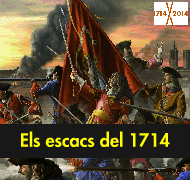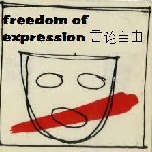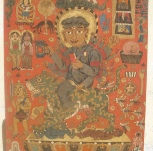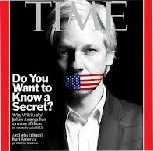


(català)
De fet és un dels primers xinesos que em va colpir, probablement per la seva combinació del real amb l'irreal, a l'estil de Magritte, el meu gran favorit. Les imatges del quadre dins el quadre sempre son fascinants. L'any passat ja en vaig voler comprar un, una mica més petit i me'n demanaven 20.000€. Ho vaig jutjar excessiu, i a més, no anava amb la resta de la col·lecció "més política". Tot i així després coneixent que la Mònica Wu portava també Zhong li vaig demanar si en tindria, de fet tenia una exposició al maig, però finalment em sembla que no es van posar d'acord amb els preus. Vaig trobar per Internet que hi hauria una exposició als USA i vaig contactar el galerista, li vaig demanar un descompte però res. El quadre que m'hauria agradat és més amb la seva nova línia, els mateixos personatges, la mateixa tècnica, però introduint elements de guerra, d'inestabilitat com helicòpters o coets. Malauradament ja venuts. Tot i això l'he pres. És el que ara queda una mica fora de la col·lecció, però és plenament Zhong Biao. No puc pensar que tothom està d'acord amb les meves idees i la meva valoració de l'art, per això tinc també que diversificar. Quan podia comprat Yue Minjun em semblaven tant estúpids i tan similars a la cara de Berlusconi que no el vaig comprar, però tampoc encara havia comprat el Wang.
L'he pagat car, a preu d'Auction, però crec que és el moment de comprar.
Quina relació té amb l'idea de la meva col·lecció? Directament poca, però com que alguna cosa li haig de trobar, diré que fa reflexionar sobre la perspectiva. Sobre que les coses es poden veure de diferents maneres, en el seu context o extrapolades, de que segons com afrontem una cosa aquesta ens donarà un resultat o un altre.
(English)
If innovation is simply the result of drawing on skillfully hidden source material, Zhong Biao may be the most innovative painter at work in China today. His gift is not to radically overturn what he's inherited and replace it with a whole new system of art and understanding - as many cutting edge European or American artists have sought to do-but rather, and simply put, he's a collector of disorienting images who paints arresting and intriguing hybrids. These distinctive pictorial inventions are accessible to people all over the world; the artist communicates to a vast audience by drawing on the familiar. His people are distinguished as ephemeral, fleeting and changing, painted in gray-scale, contrasted against the rest of the world, which is far more static, painted in rich color. As the above quote illustrates, the inclusion of a person, symbol or place doesn't always make perfect sense, so the viewer is given something in flux, a relationship to contemplate.
"We don't have to understand everything in each picture. Like our lives, we cannot make sense of everything we have seen or experienced." Zhong Biao
Steven Hawking, Marcel Duchamp, Marilyn Monroe, Alfred Hitchcock, Mao Zedong and many others all find their way into a surreal history of the world that doesn't exist outside the artist's mind. These narratives are more concerned with the passage of time, the contrast of gray-scale and color, and the juxtaposition of clashing symbols, than with explorations of the subconscious. Each is essentially a story from the past, addressing the present and speculating about the future of an accelerating and shrinking world.
Biao's synergistic mix is both pan-Asian and pan-western, drawing on images from Europe and America. Buddhist and Confucian symbols, Communist slogans and songs, commercial products emblazoned with the artist's initials, great works of literature; Zhong Biao deftly situates himself at his very own crossroads, making use of jolting juxtapositions and clashing ideologies. At its heart, the work succeeds as a transfusion between East and West as perceived by the general public and examines things we all have in common. In a calm, even adoring, way Zhong looks at the manners in which every object and bit of information can be transformed into a commodity, a frantic embracing of everything new, of incessant change. A room full of his art is a dizzying bazaar of ideas, which when multiplied against one another produce an infinity of associations. The art critic and essayist Pi Li has called Zhong Biao's process "knowledge archaeology" or "visual archaeology." He "excavates" popular histories and creates refreshing poetic combinations. Biao's work has received significant attention and commentary in essays and reviews. He recently licensed "Prosperity Brought by the Dragon and Phoenix" to Dragon Air, a Hong Kong based airline that blanketed China with the image through their ad campaign, increasing both national and international awareness of his art, and exposing him to hundreds of millions of people.
Only 40 years old, he has already exhibited in Hong Kong, Shanghai, Singapore, Thailand, Japan, Korea, El Salvador, Brazil, Germany, the Netherlands and the U.K., among other nations. We are the first gallery to represent Zhong Biao in the United States and the first place in North America where his work can be purchased. We first featured his art in our first Asian Invitational in 2004. In May of 2007, we will hold his first ever solo exhibition in the United States, consisting of approximately twelve canvases and several recent original prints. A 30 page catalogue with an essay by Cantor Center for Visual Art at Stanford University's curator Britta Erickson will accompany the exhibition.
During 2008, Zhong Biao becomes the flagship image of Chinese exhibitions in IVAM Valencia and Moscú.








